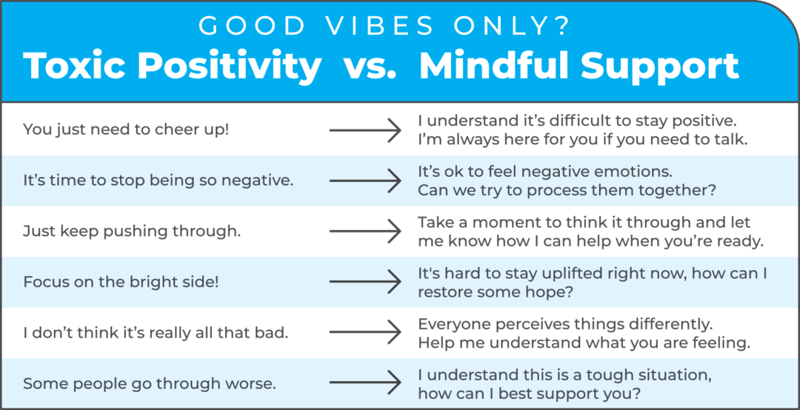Is Toxic Positivity Killing Your School Culture?
We get it: The world of education is going through a lot at the moment.
An already complex, layered, and, at times, stressful environment is being pushed to its brink by adding a global pandemic and the many consequences that have followed. The ‘21-’22 academic year has begun, and many districts throughout the country are continuing to feel the effects of COVID-19 daily. School board meetings have become heated debates over the safety of school personnel, and students and many districts are continuously impacted by the need to switch to virtual learning when COVID outbreaks occur. Emotions can be high and morale can be low.
As an administrator or educational leader, how do you find yourself responding to negativity or stressful situations within the boundaries of your schools?
Some people quickly address difficult problems with culturally driven and popular positive sayings, such as “We’re in this together,” “It could be worse,” or “Look on the bright side!” While well-intended, did you know these comments can have the reverse effect of the desired outcome and can actually decrease morale? It’s called toxic positivity, and it may be seeping into your school or district.
Today’s Decreased School Morale
Teacher morale and positive school culture have always been at the forefront of educational leaders’ minds. We understand that someone who feels valued, respected, and supported will show up each day and do their very best, even in the face of adversity.
On the other hand, administrators and leaders have an extremely full plate of tasks without the time and sometimes resources needed to truly address school culture in the manner they desire. Add in a global pandemic, new use of technology, teacher/student COVID-19 safety measures, plus virtual learning, and you have one recipe for an all-time low of teacher morale on campuses across the country.
EducationWeek (EdWeek) recently conducted a series of teacher surveys on the topic of school morale, and the findings are rather alarming. They discovered that 45% of teachers say their morale is lower now than before the pandemic. Forty-two percent are now reporting less motivation to work, and nearly one-third commented that their administration’s attempt to improve morale had no impact at all.
What is Toxic Positivity?
So, what exactly is toxic positivity, and how can something positioned as good be perceived as bad? Health experts from The Psychology Group out of Florida define toxic positivity as the overgeneralization of a happy, optimistic state that results in the denial, minimization, and invalidation of the authentic human emotional experience.
“Just like anything done in excess, when positivity is used to cover up or silence the human experience, it becomes toxic,” explains Jamie Long, a licensed clinical psychologist and co-owner of The Psychology Group. “By disallowing the existence of certain feelings, we fall into a state of denial and repressed emotions.”
When we urge people, over and over, to find the silver lining in every situation, even if done with the best of intentions, it can have adverse effects. Positive thinking does not simply exist in a vacuum and cannot be seen as a solution for all of life’s challenges; much like eating your favorite food, once you become overly full you no longer enjoy the experience, and you can even overeat enough to become sick.
EdWeek’s latest school morale survey had statements from teachers including the following thoughts:
“Save the pep talks. Seems phony.”
“Stop the comments ‘we appreciate all you do.’ These reduce morale and are frustrating.”
Ashley Marshall, a middle school math teacher that has been teaching for 10 years in North Carolina, agrees that school environments can become victims of toxic positivity.
“A common misconception or toxic positivity example I have experienced is when people say ‘teachers don’t do it for the income, they do it for the outcome,’” she said. “Teachers deserve much more than they receive, but more times than not they are compensated with ‘jeans passes’ or ‘candy in the mailbox.’“
RELATED: How to Support Your Teachers with Intention & Strategy
What You Say (and Then Do) Matters
Now that we know what toxic positivity is, what is the danger it can pose to our districts?
Samara Quintero, a licensed therapist at The Psychology Group, says, “Suppressed emotions can later manifest in anxiety, depression, and even physical illness.”
Our negative emotions are essential, and they serve a purpose. Anxiety, sadness, and anger give us a ‘red flag’ warning that something in our environment is distressing and needs to be addressed or changed. Ignoring these emotions not only fails to motivate, but also induces guilt, in addition to the immediate stress, for not being able to maintain a positive outlook.
According to Medical News Today, the danger is that people who often demand positivity from others generally offer insufficient support through difficult situations. Toxic positivity encourages people to ignore challenges, and this approach will destroy communication and the ability to problem-solve, plummeting culture and morale in its wake.
Ditch Toxic Positivity, Boost Teacher Morale, and Experience a Culture Shift
So, what can education leaders and administrators do to shift their school culture and steer clear of the morale crusher known as toxic positivity?
Allowing people to know and communicate that it’s okay to not be okay is a great first step! Start by creating a space for authentic communication that switches from popular positive sayings to statements that include mindful systems of support. Those systems often include a safe space to communicate one’s thoughts, time to process situations, and working with someone to develop impactful processes or solutions. Check out the chart below to see how you can easily adapt common toxic statements into communication that lends support and fosters hope.

Developing a space for mindful support and communication takes a well-developed strategic plan, and not every district has the time or capacity to implement a culture-focused methodology to boost morale that includes regular teacher support on their own.
“I have worked with administration who gave all the pep talks,” continued Mrs. Marshall. “Teachers need and deserve support that cannot come directly from administration or even within the school building.”
Kammi Green, engage2learn’s chief of partner success, recommends partnering with e2L to assist in creating the school culture education leaders and administrators desire to obtain. Through our intentionally designed services such as job-embedded coaching, Strategic Design, and Coaching Academy, districts can begin to shift their school culture and offer everyone from administrators and teachers to librarians and coaches the support they need to thrive.
For example, job-embedded coaching pairs educators, administrators, and district leaders with elite educational coaches that can individualize professional development and custom tailor it for each person’s needs. Medical News Today suggests that people need to talk to someone they trust and who is non-judgemental, instead of avoiding their emotions. A coach offers consistent communication that can work through difficult situations, as well as suggestions for change or growth. Simply put, a coach is the on-the-job support system we all desire.
“I have heard of job-embedded coaching, and I do think that having a coach that supported more than just curriculum would be beneficial to teachers, especially if the coaches truly ask what the teachers need help with,” stated Mrs. Marshall. She continued on to say that her biggest struggle at the moment is teaching a large class size on top of navigating a pandemic, but knows that with the right support, it would be much more manageable.
RELATED: How Teacher Coaching Transformed My District
Positive and Not Toxic
Maintaining a healthy and positive – in a good way! – school culture is not an easy task, especially amid a global pandemic. However, we know the importance and lasting impact of developing such a culture where everyone from administrators to students can thrive. It is an ongoing process and requires the establishment of systems with keen communication accompanied by support for everyone. engage2learn can be your thought partner in developing those intentional systems and strategies, as well as offering the resources needed to produce a coaching culture that will give your administrators, teachers, and ultimately students the environment to grow and flourish.



